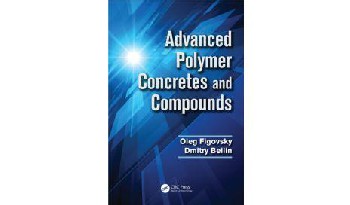
Advanced Polymer Concretes and Compounds
Олег Фиговский, Дмитрий Бейлин
Одним из способов улучшения эксплуатационных свойств строительных конструкций является использование нового класса материалов – полимерных композитов. Они обладают уникальными свойствами, которые сочетают в себе высокую прочность с характеристиками неметаллических материалов. Полимербетоны, например, открывают много возможностей для производства новых материалов с заданными физико-механическими характеристиками, такими, как улучшенная механическая прочность, низкая водопроницаемость, высокая устойчивость к химикатам. Современные полимерные бетоны и соединения представляют собой результат теоретических и экспериментальных исследований эффективных строительных материалов и композитов на основе новых полимерных связующих.
В книге рассматриваются состав, физические, механические и технологические свойства двух новых полимерных бетонов, которые имеют потенциал, чтобы решить различные вопросы, связанные со строительством: резинового бетона на основе полибутадиена и силикатного полимербетона с органо-минеральной матрицей. Анализируется поведение полимербетонов под воздействием различных факторов, долговечность и надежность изделий и конструкций из них в процессе эксплуатации. Авторы описывают новый экологически чистый полимер для монолитных промышленных полов и защитных покрытий на основе неизоцианатных полиуретанов. Они также обсуждают устойчивые к трещинам покрытия на основе водной дисперсии хлорсульфированного полиэтилена, которые могут быть использованы в авиастроении, автомобилестроении, кораблестроении, гражданском строительстве для защиты бетона, металла, пластика.
В книге описывается новый тип эпоксидного состава с нанонеоднородными структурами, обладающий большим потенциалом для улучшения механических свойств, химической стойкости и кислотоупорности строительных материалов на основе наноструктурированного связующего и современных экологически чистых и устойчивых к неблагоприятным погодным условиям огнезащитных покрытий для внутреннего и наружного применения. С акцентом на совместное применение бетонов и защитных составов для различных сред, эта книга отражает новейшие разработки в быстроразвивающейся сфере строительных материалов и машиностроения.
Features:
- Reflects the newest developments in the rapidly growing field of building materials engineering
- Includes a special chapter devoted to new environmentally friendly polymer compounds for monolithic industrial floor coverings and coatings
- Assimilates the latest information for industry and puts it into perspective
- Deals systematically with polymer matrix concretes
- Includes extensive study of the novel types of polymer concrete based on a vulcanized polybutadiene binder and nanostructured organic-silicate matrix
- Presents the data on nonisocyanate polyurethane material for monolithic flooring and protective coating—the first nanostructured environmentally friendly polyurethane coatings
- Examines specific formulation of the new polymer-based compounds for application in harsh environments—fire-protective coating and coating with high crack-resistant properties
Table of Contents
State of the Art in Polymer Concrete
Nature of Polymer Concrete
Composition of Polymer Concretes
Types of Polymer Concretes
Physical-Mechanical Properties of Polymer Concrete
Intended Use of Polymer Concretes
Advanced Polymer Concretes Based on Novel Binders
Polymer Concrete Based on Vulcanized Polybutadiene Matrix
Structure of RubCon
Physical-Mechanical Properties of RubCon
Strength of Reinforced RubCon
RubCon Creep
Chemical Resistance of RubCon
Manufacturing Process of RubCon Structures and Products
Method of Thermal Treatment of a Protective Covering Based on Liquid Polybutadiene Binder by Electric Curing
Production Technology of Fiber-Reinforced RubCon
Field Application of RubCon
Polymer Concrete Based on Organo-Silicate Matrix
Optimal Composition of Silicate Polymer Concrete
Chemical Resistance and Durability of Silicate Polymer Concrete
Adhesion Strength of Joints of Precast Silicate Polymer Concrete Structural Members
Fracture and Crack Resistance of Silicate Polymer Concrete
Nonisocyanate Polyurethanes Based on Cyclic Carbonates
Polyhydroxyurethanes and Hybrid Nonisocyanate Polyurethanes
Hydroxyurethane Modifiers
Silicon-Contained and Nano-sructured Hydroxyurethane Compounds
List of ASTM Standards Cited in Chapter 4
Crack-Resistant and Anticorrosive Coatings Based on Vulcanized Water Dispersion of Chlorosulfonated Polyethylene
Introduction
Coating Composition
Physical-Mechanical Properties and Corrosion Resistance of the Vulcanized CSPE Coating
Application of CSPE Coating for Forming Concrete and Reinforced Concrete Structures
Phenomenological Model of Crack-Resistant Coatings for Concrete Substrates.
List of ASTM Standards Cited in Chapter 5
Epoxy–Rubber Coatings with Nano-Heterogenic Structure
Structure and Properties of Advanced Epoxy–Rubber Composition
Repair and Strengthening of Reinforced Concrete Structures by Epoxy–Rubber Coatings
Nanostructured Binder for Acid-Resistant Building Materials
Composition of the Novel Nanostructured Binder
Waterborne Fire-Protective and Heat-Stability Coating Compositions
Coating Compositions
Physical-Mechanical Properties of the New Fire-Protective and Heat-Insulating Coating Compositions
List of ASTM Standards Cited in Chapter 8
Published:
December 11, 2013 by CRC Press
Content:
267 Pages | 179 Illustrations
Author(s):
Oleg Figovsky, Dmitry Beilin






